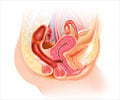- Braxton Hicks contractions - (http://en.wikipedia.org/wiki/braxton_hicks_contractions)
About
Braxton Hicks contractions, also called as prodromal labor or false labor pains are sporadic, unpredictable uterine contractions that mostly occur in late second trimester and in third trimester.
Braxton Hicks contractions prepare the body for the true, real labor. They are usually infrequent, irregular and do not last for long time. When the Braxton Hicks contractions may come more frequent, perhaps every 10 – 15 minutes in advanced pregnancy, then it is referred to as Pre-labor.

Causes of False Labor
Braxton Hicks contractions are contractions or tightening of uterine muscles for about one to two minutes to aid the body in its preparation for childbirth. Not all expectant mothers will feel these contractions. However, some common factors such as increased baby activity, excessive stress in the mother, dehydration, touching or rubbing mother’s abdomen, or having a full bladder can possibly prompt Braxton-Hicks contractions.

Difference between Braxton Hicks Contractions and Labor / Delivery Contractions
| Braxton Hicks Contractions | Labor / Delivery Contractions |
|
|
|
|
|
|
| |
| |
|
Managing Braxton Hicks Contractions
Dehydration causes muscles spasm and leads to contraction, and is one of the factors behind extended Braxton Hicks contractions. Drinking adequate water or Lemonade will help in easing pains.

False labor contractions stop when the position is changed. Hence, taking a walk when at rest or taking rest and relaxing if on foot will help in easing contractions.
Pranayama or Rhythmic breathing will alleviate the discomfort of Braxton Hicks contractions
A full bladder can trigger Braxton Hicks, so urination may ease contractions
Eating a snack or a meal can ease Braxton Hicks if caused by increased baby activity.

Having a warm bath may also help in managing intense Braxton Hicks contractions that usually occur in late pregnancy.








